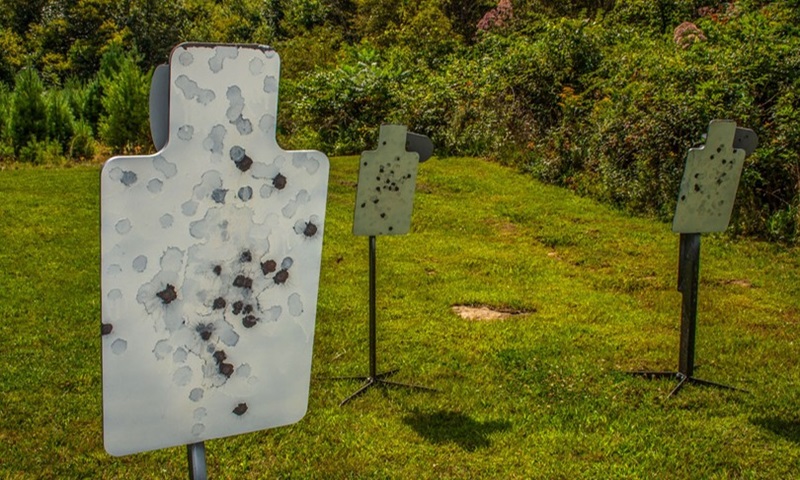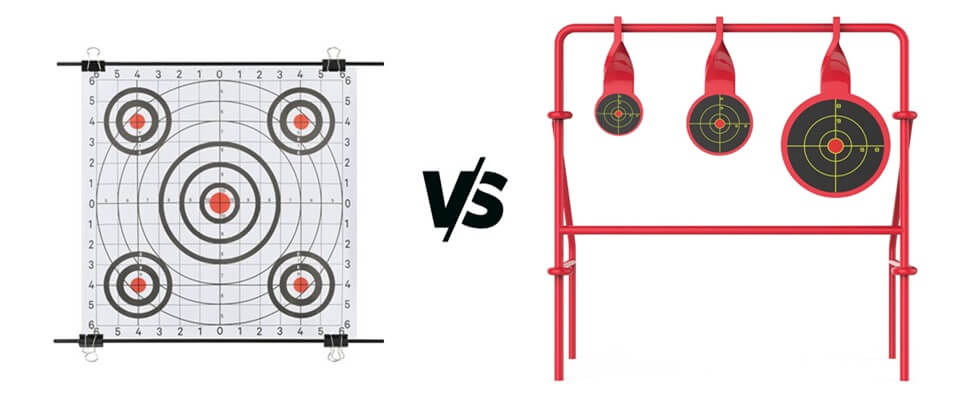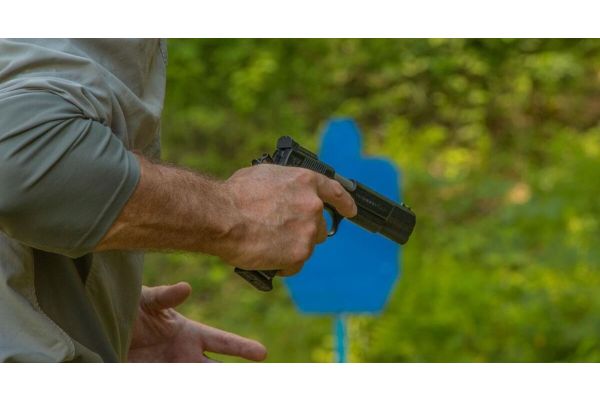Quality steel targets are a great investment for handgun shooters
It wasn’t all that long ago that you had to join a gun club or go to a nice range if you wanted to shoot steel targets.
Today steel targets are very affordable and much more portable. Lots of shooters are buying their own, and there’s good reason for this.
Stapling up targets and pasting holes takes a lot of the time, precious time that few of us want to waste while at the range.
Also, because steel targets can give immediate audible and visual feedback, they are an asset to training. However, there are some rules to follow when shooting steel targets with handguns.
The Right Kind of Hard
Steel is actually an alloy that is composed of iron and other elements. Tweaking the composition alters its properties.
To be safe and functional for use with handguns, steel targets should be made of high-quality, through hardened – not surface hardened – steel, with a minimum Brinell hardness (BHN) of 500.
Hardness is critical to maintaining a smooth surface and delivering predictable bullet splatter.
Soft steel targets will develop craters and soon look like the surface of the moon.
Steel targets with a deformed surfaces can ricochet bullets in any direction, even right back at you.


Flat Surface Is Best
The best steel targets have perfectly flat surfaces with no visible brackets, clamps, or bolts.
Some manufacturers use bolts and brackets on the target face and while not ideal, if the target is designed to move when the bullet hits it, they can be safe to shoot.
Target movement on impact and targets with their face angling downward are additional ways to make steel targets safe to shoot, especially at closer ranges.
A target that moves helps to absorb energy and redirect bullet splatter, and targets with an angled face force bullet splatter almost straight down.
Pick the Right Ammo
Most manufacturers recommend that when shooting steel with a handgun you should be no closer than 10 yards.
That’s a good rule of thumb to follow. However, the bullets you shoot steel with also matter. Low velocity lead bullets are not a good choice for steel, and never shoot steel with a BB gun.
The best bullets for shooting steel are frangible bullets, but frangible ammunition is not cheap.
Common jacketed bullets are the next best option and the polymer-encapsulated bullets used in Federal Syntech ammunition work well too.
Where you can get into trouble with steel handgun targets is if you shoot them with a rifle.
If they are indeed, through-hardened AR500 or AR550 steel, they can safely be shot with a rifle without damage, if the distance is at least 100 yards and if the muzzle velocity of the rifle is less than 3000 fps.
Don’t let fools use your targets or play on your range, and always inspect the face of steel targets before every shooting session.
Also, don’t forget to wear proper safety glasses when shooting steel targets at any distance.
Target Versatility
Steel targets are extremely versatile.
You can spray paint them in any pattern or color that pleases you, and even alternate colors to enhance training scenarios.
The main asset of steel however is the time it saves you on the range and the immediate feedback it offers.
New shooters and youths love this and you will appreciate it too. And, if you want to leave your steel targets on your range, the only maintenance they’ll need is some annual bolt tightening and paint.
My favorite steel target for handguns is the PT Hostage Target from Action Target.
It comes on a three-foot stand, has an angled 13” x 24” torso target, and a six-inch swinging head plate.
It’s also made of 3/8-inch AR550 armor steel. It’s handgun safe at 10 yards and rifle safe at 100. You can also easily move it around on the range or even transport it to the range. It only weighs 57 pounds.
At $350 it may seem a bit pricey, but I have four of these that have lived outside for a decade or more, and they’ve been shot thousands of times.
They work just as well now as they did when they were new.
Pros and Cons of Shooting Steel vs Paper Targets
Understanding the pros and cons of each target type can help you optimize your training setup.
Steel Targets
- Instant feedback
- Reusable and durable
- Time-saving—no need to change targets often
- Heavier and more expensive upfront
- Safety risks if not used properly


Paper Targets
- Inexpensive and easy to replace
- Useful for scoring and sight-in adjustments
- Lightweight and easy to transport
- Slower feedback
- Requires constant replacement and setup
Why AR500 and AR550 Steel Matter
The numbers AR500 and AR550 refer to the Brinell Hardness Number (BHN), a measurement of material hardness.
AR500 is sufficient for most handgun calibers and casual rifle use, while AR550 offers greater resistance for frequent or higher-caliber rifle shooting
Investing in the right steel hardness ensures longevity and keeps you safer while training.
Summary
Shooting steel with handguns is an exciting and efficient way to train, offering instant feedback and reduced downtime at the range.
Modern AR500 and AR550 steel targets are safe, durable, and highly portable—making them ideal for home ranges and public ranges alike. With the right setup, proper safety precautions, and suitable ammunition, steel target shooting can elevate your skills while keeping your range time engaging
From choosing the best handguns and setting up a safe home range, to understanding the pros and cons of steel versus paper targets, this guide covers everything you need to know.
Whether you're a seasoned shooter or a beginner, steel targets offer unmatched versatility, performance, and fun.
